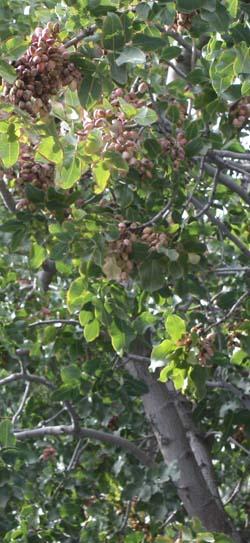Alternate Bearing
Overview | What is a Tree? | Photosynthesis & Respiration | Sources & Sinks | Fruit Quality | Tree Structure & Light Capture | Bearing Habit| Alternate Bearing | Reviewers & Credits
Alternate Bearing in Tree Fruit and Nut Crops
Alternate bearing refers to the tendency of an entire tree to produce a greater than average crop one year, and a lower than average crop the following year. Long term studies of flower and fruit production in almond demonstrated that individual spurs alternate between years in which flowers and fruits are produced and years in which only leaves are produced. Based on these observations, if the majority of spurs on a tree bear fruit in one year the tree will produce a greater than average crop, and the following year most of the spurs will produce only leaves resulting in a smaller than average crop.

- Individual spurs, not branches or whole trees, alternate leaf and fruit production each year.
- The majority of sugars produced by a leaf are transported only short distances to adjacent fruit or branch tissue.
Combined, these observations suggest that high levels of resources used in one year result in depleted local resource storage during dormancy. The following year (as a result of low resource storage), only leaves are produced. Leaves have lower resource demands than fruit and result in increased local storage for the following year when fruit are produced.
Out of all the fruit and nut crops commonly grown in California, the tendency for alternate bearing is most pronounced in pistachio. The mechanism for alternate bearing is pistachio was investigated by UC Davis Professor Polito. After pollination, as pistachio fruit grow, new flower buds develop within the branch. UC Davis Professor Polito demonstrated that growing fruit suppress developing flower buds that would otherwise mature in the next year. As a result, during years with greater than average fruit production, the majority of developing flower buds are suppressed so that the following year only a few flowers and fruit are produced. This results in regular oscillations between high and low yields in alternating years.
Weather conditions impact flower and fruit development and can exacerbate the alternate bearing tendency of individual tress or whole orchards. For example, a severe frost during bloom would kill developing flower tissue and result in a very low fruit set. As a result of the low fruit set, and reduced use of stored carbohydrates at each individual spur, the following year the majority of spurs will produce flowers and set fruit. If all spurs on a tree are synchronized to flower during the same year it will generate a whole tree, and even whole orchard, pattern of alternate bearing.
An understanding of the mechanisms responsible for alternate bearing in fruit and nut tree crops is important when critically evaluating the range of pruning and training strategies commonly used by growers to minimize alternate bearing.
